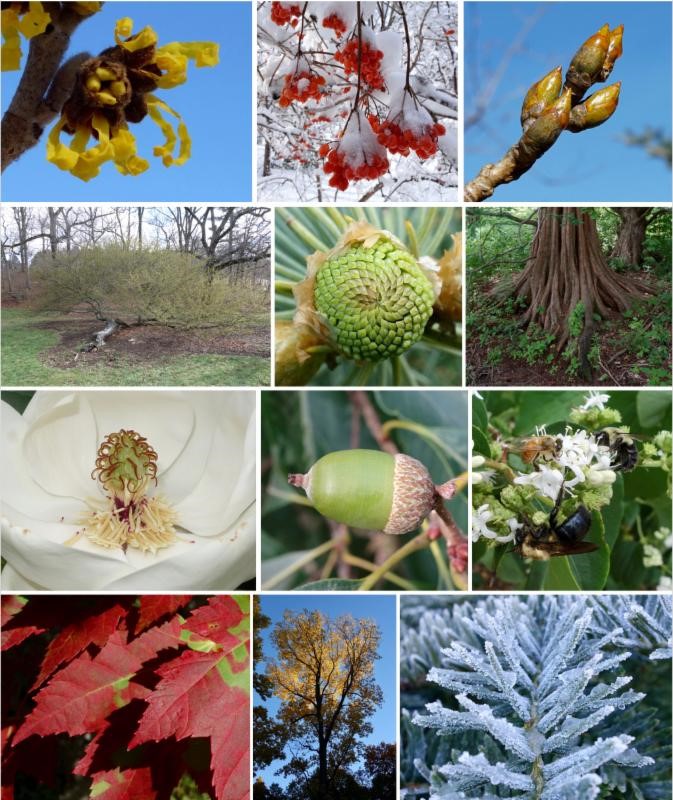“Two roads diverged in a yellow wood…” Well, you know the rest. But, if I may, please make a resolution for 2017 to step off your familiar paths in the Arnold Arboretum and explore some new territory, with magnificent plants and vistas yet unseen. And if you have not been to the Arnold Arboretum recently, I hope you will resolve to make it once again a regular part of your life. It will make all the difference.
To begin 2017, I share 12 pictures from my wanderings in the Arnold Arboretum in 2016. With 15,000 accessioned specimens in the living collections, I too have much yet to explore and photograph. And so, I resolve to wander even more in the coming year.
January 21, 2016. Chinese witch hazel (Hamamelis mollis, 273-29*B). Last winter, the witch hazels were subtle and spectacular, including this 1929 accession tucked quietly in the Centre Street Beds.
February 6, 2016. Variety of European cranberry bush (Viburnum opulus var. calvescens, 719-88*B) with 2015 fruits still hanging from the shrub after a beautiful snowstorm.
March 1, 2016. Eastern cottonwood (Populus deltoides ssp. deltoides, 22099*A) with sticky-looking, shiny buds on a crisp blue-sky day.
April 8, 2016. Variety of Hall’s crabapple (Malus halliana var. spontanea, 10796-2*A) at the bottom of Peters Hill, having been knocked over (by vandals) years ago, the light green of budbreak announces that spring is underway and that this most resilient crab will be with us another year.
May 4, 2016. Narrowscale dragon spruce (Picea asperata var. notabilis, 12-96*A) scion repropagation from a specimen (seed) collected over a century ago by E. H. Wilson in China. This small tree is the perfect plant for observing the amazing spiral symmetry of needles emerging from bud.
June 16, 2016. Dawn redwood (Metasequoia glyptostroboides, 524-48*LL), one of the original “exports” from the 1948 batch of seeds that came from China shortly after it was discovered that this stunning deciduous conifer had not gone extinct two million years ago after all. The grove of dawn redwoods on the east side of Peters Hill seems almost primeval.
July 7, 2016. Magnolia ‘Freeman’ (830-75*A) is a hybrid resulting from a cross between M. virginiana and M. grandiflora at the National Arboretum. This specimen (just inside the gate and only yards from the Centre Street sidewalk) surprised me with its very late flowering and amazing fragrance. The stigmas have turned brown and the stamens have begun to fall away, revealing their intense purple bases.
August 19, 2016. Glandbearing oak (Quercus glandulifera, 763-81*A) among the majestic and old Asian oaks on the backside (east) of Bussey Hill.
September 24, 2016. Seven-son flower (Heptacodium miconioides, 1549-80*H) from one of the seeds collected on the groundbreaking 1980 Sino-American Botanical Expedition. Here, three different species of bee are oblivious to one another, but very focused on sipping nectar.
October 3, 2016. The Schlesinger cultivar of red maple (Acer rubrum ‘Schlesingeri’, 408-918*A), almost always to first to show red in late summer. The discrete patchiness of red and green on each leaf is impressive.
November 4, 2016. Bitternut hickory (Carya cordiformis, 12893*H) collected from seed by Charles Sprague Sargent and accessioned in 1883―in the late afternoon sunlight, radiating pure gold.
December 6, 2016. Cultivar of a hybrid yew (Taxus x media ‘Thayerae’, 17653*J). The day before had brought a bit of snow, then rain, and then a humid overnight freeze. I snuck out of my office in the morning to catch the ice crystals on the plants before the sun melted them away in just minutes. Pure magic!
To see these pictures in higher resolution, head over to this Flickr page.
